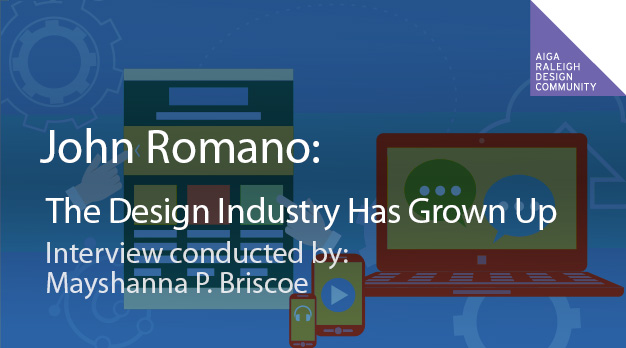
We cannot get enough of UX and we know you cannot either. The more I learn the more I want to know. Here is explain more of the finer points is John Romano. John is a UX Director that designs mobile apps and Web sites at PointSource in Raleigh. He enjoys working on collaborative, multi-disciplinary teams to find creative solutions that simultaneously delight users and satisfy business requirements. He’s also a speaker, tinkerer, dad, outdoorsman and deep-frying enthusiast.
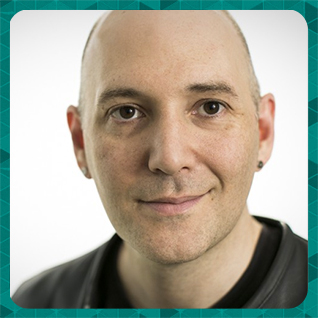 What is your background in creative community?
What is your background in creative community?
UX design is a field that often attracts people from other professions who enjoy the practical problem solving that UX designers face each day. It’s a great career for someone whose mind isn’t purely left- or right-brained. I started my career as a graphic designer and have worked as a developer and as a UX designer. This is why I enjoy proselytizing for UX design in the AIGA. I also lend a voice to the TriUXPA, where I’m on the advisory board.
What is your design process?
I tend to follow a modified user-centered design process. The user’s needs and context need to be of primary concern all through the design process. I say “modified” only because I believe that good design doesn’t focus solely on the needs of the user. The best design seamlessly satisfies the needs of the user with the goals of the business.
I prefer to practice UX in an agile environment because the speed of the sprints require that you collaborate with others. You need to fail faster, design faster, and focus on outcomes, not deliverables. In my perfect world, UX designers wouldn’t spend time creating throw-away deliverables but would instead spend their time designing in an iterative process in collaboration with others. I find that is the best way to deliver the best project.
User Experience seems to have appeared out of nowhere. Why do you think UX has becoming so important to companies?
The design industry has grown up. The skills sets needed to plan, design, and execute complex digital products and services have become broad and deep. While there are those rare individuals that have the abilities and skillsets to do the work end-to-end, the reality is that the body of knowledge is so broad that specialization is now commonplace.
The result is that there are potentially a lot of people at the table: creative directors, designers, copywriters, developers, business analysts, and many more–not to mention the clients and the decision makers. While in theory these folks are united in their desire to make something that’s both valuable for the users and profitable for the client, it’s not uncommon that the needs of the actual users are forgotten about. That’s where the user experience (UX) designer comes in. It’s his or her job to advocate for the user and make things more usable.
The increasing value of UX is connected to the realization that customer experience is critical to financial success online. In its role as the customer’s advocate, UX designers are now recognized as an important part of a very powerful equation that equates positive customer experience with increased conversion and improved key performance indicators.
At the same time, the ability to closely measure the results of our efforts has given us new insight into the value of usability. Sites and apps that give users what they want in a usable way tend to be more effective and more profitable. And UX designers have created a feedback loop (with the help of folks in analytics) that works to constantly improve site performance.
Put simply, UX designers help companies meet the needs of the users, and by doing so, help companies to be more successful.
What do UX designers do?
UX design includes a broad range of tasks that tend to include:
- User research
- Information architecture
- Interaction design
- User testing
Any one of these might be a practitioner’s sole focus of attention at a large organization that employs many specialists. But often one UX designer does all of these activities within the context of a single project. In fact, having the same person who talked to users during the research phase be in the room during co-design sessions with graphic designers and developers is the best way to bring the voice of the user into the final solution.
User research is all about defining the users and discovering their needs. This might include surveys, interviews, focus groups, field research, or research into existing documentation. The result is often a persona.
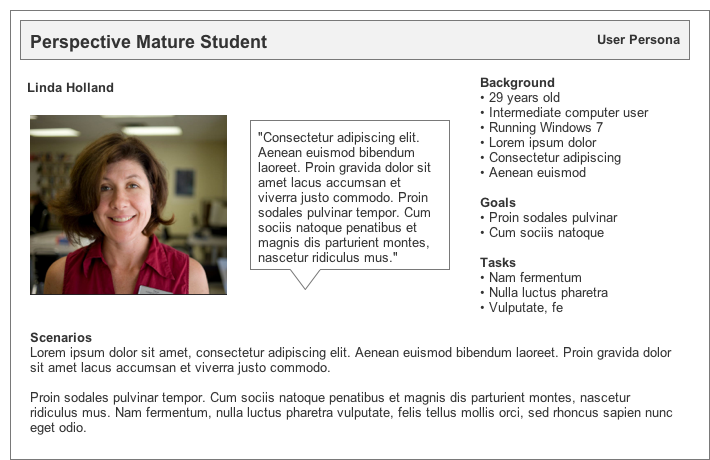
Photo courtesy of University of the Fraser Valley
Information architecture is about understanding the content at hand and organizing it in a user-centered way. This often means creating a hierarchy or taxonomy that gives users a handle on large amounts of data. The result is often a sitemap that defines navigation or a tagging system for more complex data structures.
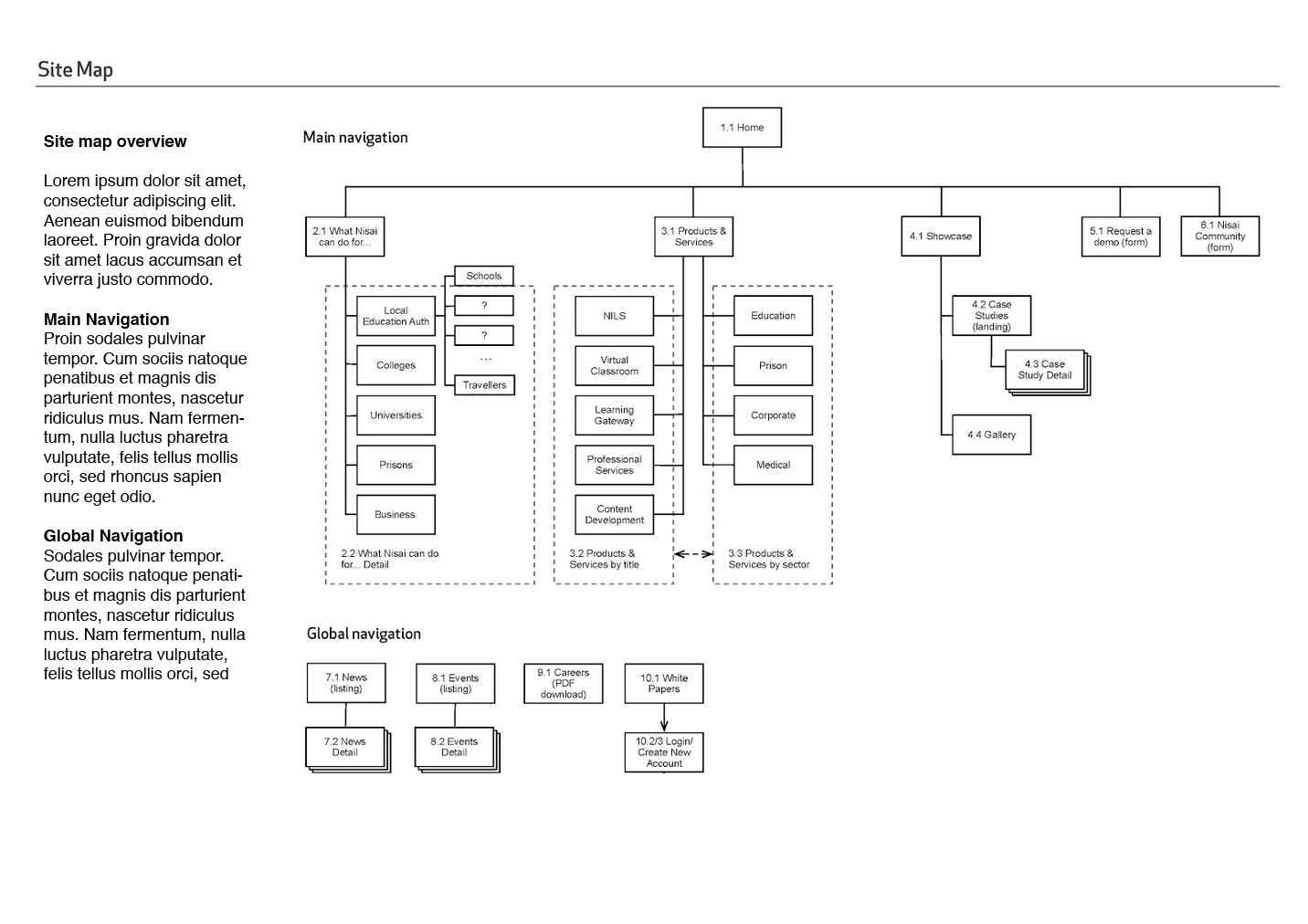 Interaction design is about the creation of an interface. The UX designer is involved to help translate the discoveries from user research into friendly, enjoyable, and usable interface experiences. There’s definitely lots of overlap here with the graphic designer, and the best outcomes are when the two collaborate to create something that works well, looks beautiful, and is on-brand. The result of the UX designer is usually a wireframe or prototype.
Interaction design is about the creation of an interface. The UX designer is involved to help translate the discoveries from user research into friendly, enjoyable, and usable interface experiences. There’s definitely lots of overlap here with the graphic designer, and the best outcomes are when the two collaborate to create something that works well, looks beautiful, and is on-brand. The result of the UX designer is usually a wireframe or prototype.
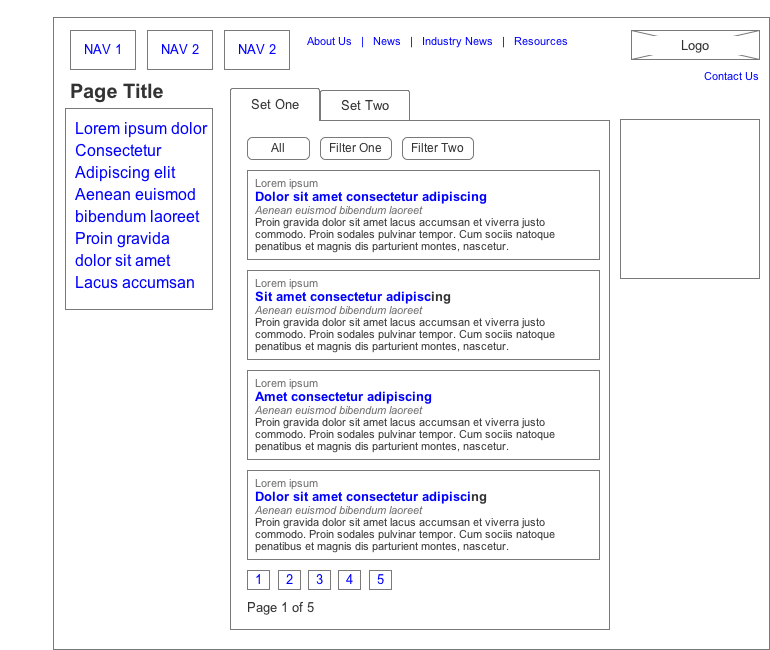
User testing is the way to close the loop. We discover, design, develop, test, and then start the cycle over again. Testing puts our solutions in front of users and gets them to evaluate what’s working and what isn’t. Here the outcome is a list of recommendations about how to improve the interface.
Side note: in my experience, user testing is the best way to resolve conflicts between project participants who have opposing points of view. Have you ever been in a standoff with a client or stakeholder, in which you have two sound, yet opposing points of view? The UX way around the issue is by saying “let’s test it with users and find out.” You side-step opinion and let effectiveness answer the debate.
When you start a new UX project, what types of questions do you ask yourself?
UX design is fundamentally about understanding and designing to the needs of the user. So the first logical question to ask is “Do I understand the user?” To this end, we look to answer the following questions.
- Who are the users?
- Are there groups of users, each with their own needs?
- What are their needs, motivations, and pain points?
- What scenarios and contexts are they in?
But remember, users’ needs only represent half of the equation. Let’s not forget about the business requirements. Sometimes these requirements are documented by a business analyst, but sometimes the UX needs to help define these as well.
- What are the goals of the business?
- What are the technical requirements?
- How will we define and measure success?
Design for the UX designer then becomes finding the fertile middle ground between user needs and business requirements.
How do UX designers learn about the end user?
Understanding the user is easy when you’re one of them. But, in the event that you aren’t, the first order of business would be to do some user research.
User research is an invaluable tool that helps us identify and understand our users. We start by breaking up the entire audience into segments. For example, a technology company might have audience segments for technology buyers, decision makers, and procurement officers. We use a “persona” to define each of the segments. Think of a persona as a tool that lets us picture a user who represents a group. It should define the needs, pain points, motivations, and device habits. It may also describe the scenarios that the audience segment might find itself in when interacting with the product.
Design is as much about what not to do as it is what to do. So we identify which personas are primary, secondary, and tertiary and then use that information to prioritize the functional requirements. We work to fulfill the needs of the primary audience first. If our secondary and tertiary audiences also have the same requirements, then those are requirements to move to the front of the list. But you have to make critical decisions about what to include and the best way to decide what to eliminate is to prioritize features and content by audience segment.
How does the UX designer test the prototype?
At some point interaction design starts, and the UI begins to unfold. There are many ways to design and build the UI. One way is with a disposable UX deliverable called a wireframe. The wireframe, at its simplest, is an unstyled representation of the interface with boxes, links, labels, and copy. The primary purpose is to define the elements of a page and their relative importance to each other. Therefore, keeping the wireframe unstyled is critical. Any styling can confuse the purpose and make the client or the users start to ask, “Is this going to look this way?” (with a grimace).
The wireframe might be a series of flat images. It could also be done in an interactive format that we call a prototype. Before putting a prototype together ask yourself what the goal of the prototype is. This question will help you determine how early to build it and how much time to commit to its construction.
Prototypes vary in their representation of the finished interface. Rough, low-fidelity prototypes are great for validating big ideas and design decisions early, and higher fidelity wireframes are good for testing more nuanced interactions.
What’s important to remember is that prototypes are throw-away deliverables. They’ll never see production. Their construction and use means budget burned. I recommend testing early and often. It’s better to fail earlier when you still have time to pivot. With higher fidelity (more costly) wireframes, you have to ask yourself if the cost is worth it. It might be better to develop the interface in production-ready code, since the more nuanced improvements you realize might be easily accommodated by the dev team without wasting money on a throw-away deliverable.
What tools or techniques do you use?
The tools of the UX trade will seem familiar to any graphic designer. You could do user research with any basic word processor. Information architecture content audits are typically done in Excel, and sitemaps are often created in visual programs like OmniGraffle or Visio (but could easily be done in Illustrator). Interaction design might be done right in HTML, or it might be done in wireframes, made with desktop apps like Axure or web-based prototyping tools like UXPin. But they also can be done in Illustrator or Photoshop. Low-fidelity prototypes can be as simple as cut paper mock-ups but are often built with Axure or web-based prototype services like Flinto.
UX designers work in a wide variety of organizations: design shops, agencies, start-ups, and inhouse corporate. They also work in waterfall and agile organizations. This variety forces UX designers to be scaleable. For example, user research can result in personas or in a detailed research report. Interaction design can result in fast sketches or in high-fidelity wireframes.
Regardless, I think sketching is just as important in UX design as it is in graphic design. Keeping things fast and fluid for as long as possible is an important technique to prevent yourself from losing focus on the design and getting derailed by documentation and pixel-perfect details.
How can UX designers most effectively collaborate with visual designers?
Because UX designers work with many other practitioners, many of the techniques tend to be collaborative in nature. Interaction design work can’t be done in a vacuum. When designing UI for web and mobile, the interface needs to be looked at through the development and design lens, as well as the usability point of view.
For this reason, I recommend that the UX lead co-design sessions with a developer and a graphic designer. While others can be added (content strategists, analytics specialists, BAs, etc.) this core group addresses many of the UI challenges. In these sessions, the UX can advocate for the user (and maybe also for the business) as interfaces are designed to meet all of the challenges. This collaborative approach also ensures that there is critical buy-in from other team members, that all limitations have been identified, and all opportunities are exploited and explored.
Is UX design just for web/mobile applications?
Actually, the idea that a UX designer can provide a focus on the end user was borrowed from product design. The UX field grew out of human factors and ergonomics.
But even more broadly, some would argue that all designers are “user experience designers.” After all, aren’t we all in the business of creating experiences for others? But I think this definition is so broad as to be unusable. I tend to think of UX design as a complementary design practice. In Web and mobile applications, the shared output of UX and graphic design is the user interface. The graphic designers focus on and ensure that it’s brand aligned, visually pleasing, and readable. The UX designer ensures that it meets user needs and is usable, contextual, and aligned with business goals.
How do you keep current on the latest information about UX design or design in general?
Professional groups and conferences help. Working with other talented and interested UX designers is great too. That and reading. Lots of reading. Smashing Magazine, UX Magazine and Boxes and Arrows are all great resources to follow.
If you want to learn more about John Romano:
Twitter: twitter.com/johnwromano
Linkedin: linkedin.com/in/johnwromano
Website: johnwromano.com
Please take a few moments to take this survey and look for our upcoming posts on UX design and the web!
 Author of this post: Mayshanna Pandora Briscoe is a Freelance Graphic Designer, Mixed Media Artist and Aspiring Blogger. She has a B.A. in International Business and A.A.S. in Advertising and Graphic Design with a Certificate in Web Technology. When she is not in her studio she can be found experimenting with a new recipe, posting pictures of her design life or food on Instagram, or making memories with her fan club (aka her friends, family and dogs).
Author of this post: Mayshanna Pandora Briscoe is a Freelance Graphic Designer, Mixed Media Artist and Aspiring Blogger. She has a B.A. in International Business and A.A.S. in Advertising and Graphic Design with a Certificate in Web Technology. When she is not in her studio she can be found experimenting with a new recipe, posting pictures of her design life or food on Instagram, or making memories with her fan club (aka her friends, family and dogs).